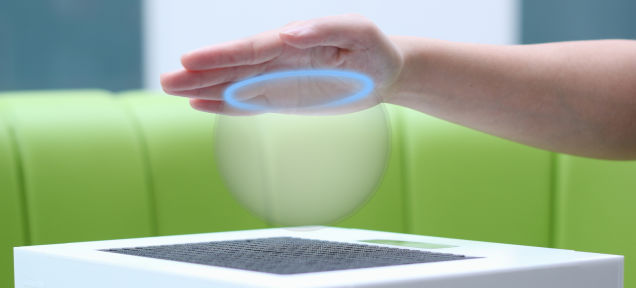
Haptics is a growing field that aims to allow our bodies to control and ultimately ‘feel’ our virtual identity. Instead of using the theorized mechanism of a neural computer link, haptic tech attaches sensors and stimuli to our body. A report by research firm Markets and Markets thinks haptic technology, which could soon include something like a glove that let’s you move a hand in cyberspace, will be worth 30 billion by 2020.
Haptic technology, also known as kinesthetic communication, sounds like something out of science fiction. But products, like the vibrating cell phone, have been out for decades. And there’s more advanced systems on the way. That’s partly because of another hyped field: virtual reality. With pioneering virtual reality headsets like the Oculus Rift poised for release next year, the question becomes: How to make this experience even more immersive.
A question haptic tech looks to answer.
The tech is based on our sense of touch, a sensation that philosopher John Locke believed to be the most undeniable of all human senses. We believe something is real by touching it, a philosophy that haptic technology follows.
Imagine wearing a body suit and a headset that transports your vision to some digital landscape. The suit would be equipped with a range of sensors that detect movement and maybe even more subtle biological signs like sweat. By moving in your suit you direct your virtual identity, making your body a kind of joystick.
The suit brings control and sensation. Say you’re reaching out your hand to interact with a digital rose and touch a thorn, you would feel a physical prick. That’s because your haptic suit is equipped with the ability to direct and react with tactile sensations. Haptic technology can also be equipped to respond with motion, pressure and vibrations to our digital actions. The experience brings virtual reality closer to reality.
A research paper, published in the current issue of ACM Transactions on Graphics demonstrates how a method has been created to produce 3D shapes that can be felt in midair. The researchers believe a holographic body could one day be created from a CT scan and studied and felt by surgeons.

Future haptic technology will be a key fixture in medicine and virtual reality entertainment, which is why the industry is predicted to grow speedily.
Markets and Markets points out the hurdle haptic technology faces in software compatibility. Haptics is still a new field so there isn’t uniformity across software yet. No software standard for haptic tech would mean it doesn’t achieve the growth it needs.
So, if you’re a fan of the future of virtual reality: cross your fingers.